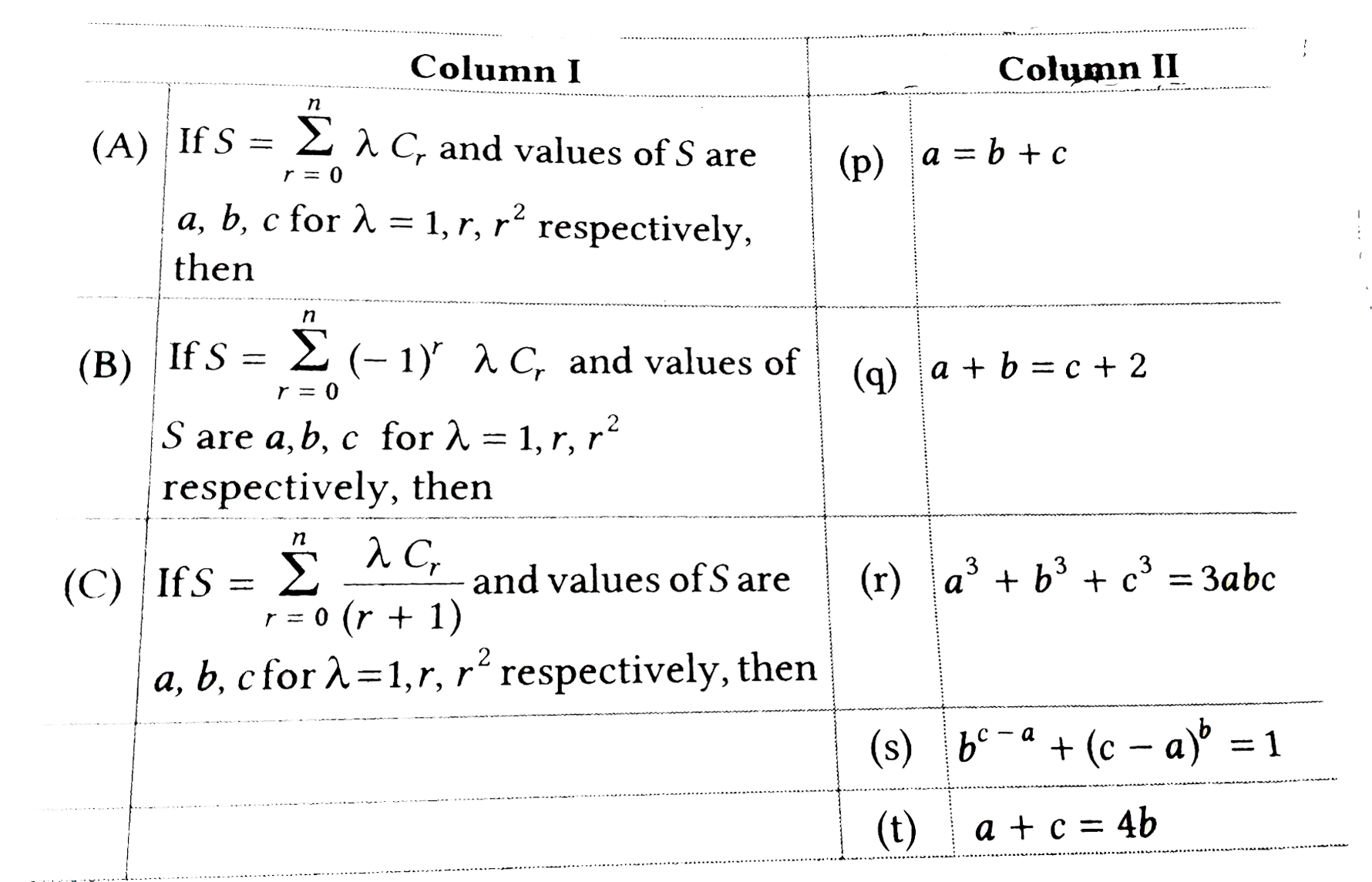Prove that :C0−3C1+5C2−………..(−1)n(2n+1)Cn=0
To prove the statement C0−3C1+5C2−…+(−1)n(2n+1)Cn=0, we will follow a systematic approach using the properties of binomial coefficients and summation.
1. Understanding the Expression:
The expression can be rewritten in summation notation:
S=n∑r=0(−1)r(2r+1)Cr
where Cr is the binomial coefficient (nr).
2. Expanding the Term:
We can separate the term (2r+1) into two parts:
S=n∑r=0(−1)r(2r)Cr+n∑r=0(−1)rCr
Thus, we can denote:
S=2n∑r=0(−1)rrCr+n∑r=0(−1)rCr
3. Using the Binomial Theorem:
The second sum n∑r=0(−1)rCr can be evaluated using the binomial theorem:
n∑r=0(−1)rCr=(1−1)n=0
4. Evaluating the First Sum:
For the first sum n∑r=0(−1)rrCr, we can use the identity rCr=nCr−1:
n∑r=0(−1)rrCr=nn∑r=1(−1)rCr−1=nn−1∑s=0(−1)s+1Cs
where we substituted s=r−1.
5. Evaluating the New Sum:
The sum n−1∑s=0(−1)s+1Cs is:
−n−1∑s=0(−1)sCs=−(1−1)n−1=0
6. Combining the Results:
Since both sums evaluate to zero:
S=2⋅0+0=0
7. Conclusion:
Therefore, we have shown that:
C0−3C1+5C2−…+(−1)n(2n+1)Cn=0
Hence, the statement is proved.
The expression can be rewritten in summation notation:
S=n∑r=0(−1)r(2r+1)Cr
where Cr is the binomial coefficient (nr).
We can separate the term (2r+1) into two parts:
S=n∑r=0(−1)r(2r)Cr+n∑r=0(−1)rCr
Thus, we can denote:
S=2n∑r=0(−1)rrCr+n∑r=0(−1)rCr
The second sum n∑r=0(−1)rCr can be evaluated using the binomial theorem:
n∑r=0(−1)rCr=(1−1)n=0
For the first sum n∑r=0(−1)rrCr, we can use the identity rCr=nCr−1:
n∑r=0(−1)rrCr=nn∑r=1(−1)rCr−1=nn−1∑s=0(−1)s+1Cs
where we substituted s=r−1.
The sum n−1∑s=0(−1)s+1Cs is:
−n−1∑s=0(−1)sCs=−(1−1)n−1=0
Since both sums evaluate to zero:
S=2⋅0+0=0
Therefore, we have shown that:
C0−3C1+5C2−…+(−1)n(2n+1)Cn=0
Hence, the statement is proved.
Topper's Solved these Questions
- BIONOMIAL THEOREMBook:ARIHANT MATHS ENGLISHChapter:BIONOMIAL THEOREMExercise:JEE Type Solved Example : (Matching Type Questions )
Explore 1 Video
- BIONOMIAL THEOREMBook:ARIHANT MATHS ENGLISHChapter:BIONOMIAL THEOREMExercise:Exercise For Session 1
Explore 7 Videos
- AREA OF BOUNDED REGIONSBook:ARIHANT MATHS ENGLISHChapter:AREA OF BOUNDED REGIONSExercise:Exercise (Questions Asked In Previous 13 Years Exam)
Explore 23 Videos
- CIRCLE Book:ARIHANT MATHS ENGLISHChapter:CIRCLE Exercise:Exercise (Questions Asked In Previous 13 Years Exam)
Explore 16 Videos
Similar Questions
Match the following Column I to Column II

View SolutionThe value of 10∑r=0r10Cr3r(−2)10−r is 20 b. 10 c. 300 d. 30
View SolutionArea of the region
{(x,y)∈R2:y≥√|x+3|,5y≤x+9≤15} is equal to
View Solutionabout to only mathematics
View SolutionIf (1+x)n=c0+c1x+c2x2+...+cnxn then the value of c0+3c1+5c2+....+(2n+1)cn is-
View Solutionprove that :C_(0)^(2)+3C_(1)^(@)+5C_(2)^(2)+...+(2n+1)C_(n)^(2)=((n+1)2n!)/((n!)^(2))
View SolutionC_(0)-3C_(1)+5c_(3)+....+(-1)^(n)(2n+1)C_(n) is equal to
View Solution3C_(0)+5C_(1)+7C_(2)++(2n+3)C_(n)=2^(n)(n+3)
View SolutionProve that :C0−3C1+5C2−………..(−1)n(2n+1)Cn=0
View SolutionProve that (2nC0)2−(2nC1)2+(2nC2)2−.....+(−1)n(2nC2n)2=(−1)n.2nCn
View Solutionसिध्द कीजिए कि C0+2C1+3C2+.....+(n+1)Cn=(n+2)2n−1.
View Solutionसिध्द कीजिए कि -
C0−2C1+3C2−......+(n+1)(−1)nCn=0
View Solutionयदि (1+x)nके प्रसार में गुणांक C0,C1,C2,.......Cn हों , तो सिद्ध कीजिए कि :
C1−2C2+3C3−.......+n(−1)n−1Cn=0.
View SolutionThe value of
C0+3C1+5C2+7C3+...+(2n+1)Cn is:
View Solutionlf Cr=nCr, then C0−13C1+15C2…… upto (n+1) terms equal
View Solution
